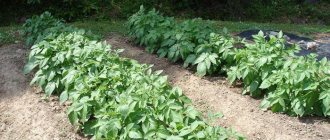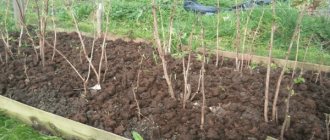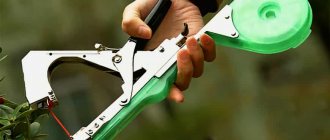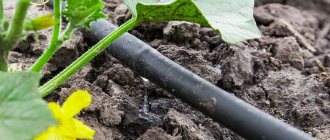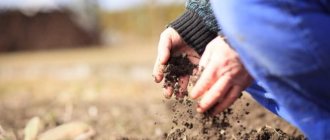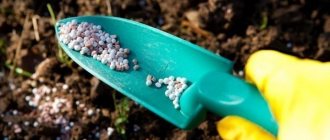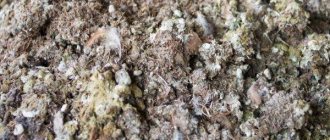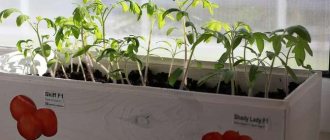To improve the health of potatoes, it is necessary to use fertilizers. Sometimes gardeners are afraid to use them, believing that root vegetables will absorb a lot of “chemicals”. But there are safe drugs that will not harm the harvest, but, on the contrary, will increase it.
Potatoes are truly a unique “resident” of our gardens. It differs from other crops not only in its properties, but also in the special procedure for applying fertilizers. In particular, the bulk of fertilizers are applied during the planting period of potatoes, since during the growth process they are absorbed less well and do not have a significant effect on the growth and development of plants. We will talk about this and other features of fertilizing below.
Why fertilize potatoes?
Potatoes, like tomatoes, are vegetables of the same family, Solanaceae. In science, the crop is called tuberous nightshade (Solanum tuberosum) - a herbaceous tuberous perennial.
Reference. We owe the appearance of “earth apples” in Russia to Peter I. The Russian Tsar brought a bag of tubers from Holland at the end of the 17th century. Gradually, by the mid-19th century, the root vegetable literally became the second bread.
Due to the “kinship”, the requirements of potatoes for basic nutrition and seasonal feeding are very similar to those for fertilizing tomato seedlings. But still, some features of growing, planting and care exist.
Let us dwell in more detail on the important factors and features of seasonal fertilizing that directly affect the full ripening of a high-quality and rich harvest.
Factors affecting yield
Let us highlight the mandatory procedures that directly affect high potato yields:
- pre-sowing soil nutrition with nitrogen, phosphorus and potassium (autumn or spring);
- preparation of planting material (processing of tubers before planting);
- nutritional mineral supplements before and after potato flowering;
- pre-harvest desiccation (drying of tops);
- preventive feeding (adding a complex of microelements and fungicides).
Application of industrial products
Mineral and organomineral fertilizers are produced industrially.
- Mineral. Inorganic compounds, which include elements necessary for the growth and development of plants: nitrogen, phosphorus, potassium.
- Organomineral. They contain not only mineral compounds, but also organic substances.
The use of industrially produced fertilizers allows you to quickly and in the right quantities saturate the soil with the necessary nutrients. But their use requires strict adherence to the prescribed application rates.
Ammonium nitrate (ammonium nitrate, ammonium nitrate)
A mineral supplement that contains nitrogen and sulfur, which helps the plant absorb it better. The nitrogen content varies among different manufacturers from 26 to 34.4%, sulfur from 3 to 14%. Available in the form of yellowish-white granules.
For fertilizing, ammonium nitrate is used in dry and dissolved form. When using nitrate on acidic soils, additionally add calcium carbonate at the rate of 75 g per 100 g of nitrogen fertilizer.
Urea (urea)
The product is in the form of white or yellowish granules, or in tablets. The nitrogen concentration in urea reaches 46%. Used in dry and liquid form.
The mild effect of urea on the above-ground part of the plant makes it indispensable for foliar feeding. Urea not only supplies potatoes with nitrogen, but also improves the plant’s immunity, inhibiting the proliferation of bacteria and the development of fungal infections.
Azofoska (nitroammofoska)
Granules are pink or whitish in color depending on the concentration of active ingredients. Nitroammophoska is produced in the following dosages of nitrogen, phosphorus and potassium (NPK):
- PK 16:16:16 – suitable for annual use;
- NPK 19:9:19 – used on soils rich in phosphorus;
- NPK 22:11:11 – used on depleted land.
Azofoska additionally contains sulfur. Can be used alone or in mixtures. It is not recommended to apply into cold soil.
Ammofoska
Due to the absence of chlorine and sodium in the composition, the fertilizer has a mild, gentle effect. The granules contain the following percentages: nitrogen 15%, phosphorus 15%, potassium 12%, sulfur 14%. Used for root and foliar feeding from early spring to late autumn.
Nitrophoska
A mineral fertilizer containing nitrogen, phosphorus and potassium in equal or almost equal proportions. Externally it is white granules.
An important feature of this supplement is the different timing of the onset of action of nutrients. Nitrogen and potassium require 2–3 days to decompose, and phosphorus almost 2 weeks. There are phosphorite, sulfate and sulfuric acid versions of this fertilizer. It is the latter that is most often used for potatoes.
Superphosphate and double superphosphate
White powder or granules. It is most often used by adding it to the soil, but it is also possible to use it in the form of a solution. Suitable for soils with high acidity levels.
The effectiveness of superphosphate will be higher if it is not mixed with other mineral fertilizers.
Potassium humate
Produced in the form of granules, powder, tablets, liquid. Contains: phosphorus, potassium, nitrogen, humic and folic acids. It is optimal to use fertilizer at the initial stage of potato growth. The high concentration of nutrients requires careful use, with a clear calculation of the dose applied.
Potassium sulfate
White granules of the product contain potassium oxide 50%, sulfur 17%, magnesium 3%, calcium 0.4%. It is used both in spring and during the period of budding and flowering, when the need for potassium and microelements is increased. Fertilizing helps the plant resist drought and prevents the development of fungal diseases.
Gardeners also appreciated the benefits of formulations specially developed by manufacturers for potatoes:
- Potato fertika – 5;
- Bona Forte;
- Kemira for potatoes;
- Gera potato.
Fertilizing the soil before planting potatoes
Do I need to feed potatoes? Everyone's favorite root vegetable forms, grows and ripens in the soil. Naturally, without enhanced nutrition it will not be possible to dig up a “treasure” in the form of a luxurious harvest.
Everyone knows that it is necessary to fertilize the soil before planting tubers. It is also important not to skip fertilizing during growth periods that are critical for the crop.
What fertilizers to apply in the fall for digging?
It is important to prepare the soil for planting potatoes in the fall. During autumn plowing, dolomite flour as a deoxidizing agent. Potatoes prefer neutral to slightly acidic soil.
Fertilizing the soil for potatoes with organic matter - manure, humus, compost, wood ash - will enrich the fertile layer in the root system zone.
Before winter, the best fertilizer for potatoes will be sowing green manure:
- until mid-September - mustard, rapeseed;
- until the beginning of October - winter rye.
Important! Mustard is sown in temperate climates and cold regions. Rapeseed does not like moisture and cold very much, it does not tolerate night temperature changes well, it is sown in the southern regions.
Green fertilizers ensure the exchange of beneficial microflora and improve soil fertility by 2-3 times. Pre-winter planting of green manure after potatoes replenishes the supply of nutrients and promotes natural loosening of the soil.
Mineral fertilizers : ammophos, diammophos, calcium nitrate - applied in the fall. Feature - phosphorus serves as a reserve; gradually until spring the nutrient element will dissolve and become available to plants. The granules are buried by 10-12 cm when digging the area.
Preparing soil for potatoes
In addition to basic soil nutrition with nitrogen, phosphorus, potassium and a complex of microelements, care must be taken to disinfect the soil.
To save the crop from diseases and garden pests, the area must be treated with special disinfectant preparations:
- Entocide;
- Boverin;
- Metarizin;
- Verticillin.
Modern safe disinfectants solve the problem of healthy biologically active soil, resist the appearance of mole crickets, chafer larvae, wireworms, and wintering Colorado potato beetles.
How to fertilize potatoes when planting? Directly when planting seed tubers, organic or mineral fertilizers are added to each hole:
- microbiological fertilizers (for example, Baikal);
- compost, Bokashi, rotted manure, bird droppings, humus;
- urea, saltpeter, superphosphate, potassium sulfate (in equal parts, 15-20 g each).
Attention! If the soil is fertile and abundant fertilizing was carried out in the fall, then it is not necessary to add fertilizer to the hole.
Preparing tubers before planting in a hole
Experienced farmers claim that pre-sowing spring soil preparation for planting potatoes is best done 3-4 weeks before planting tubers in order to start the processes of enriching and structuring the soil.
You need to prepare the seed for planting in advance.
Mandatory conditions for preparing seed potatoes for planting in the spring :
- “Like the seed, like the tribe ,” people say. Following folk wisdom, only large, smooth, even, undamaged tubers are selected for planting. Underdeveloped small potatoes will not produce a good harvest. A tuber of irregular shape (in the form of a figurine, heart, etc.) is a sign of degeneration of the crop and is not suitable for planting. Plants from such tubers will become sources of viral infections.
- Store tubers for planting in cool rooms ; low temperatures protect against premature growth of sprouts. The tuber itself retains all nutrients, starch, and sugar until spring. Nutrient elements will ensure uniform development and growth of the future crop.
- Warming up the tubers is a must for small summer cottages and large farms. 3-4 weeks before planting, seed potatoes are transferred to a bright, warm place and scattered on the floor in one layer.
- in the light . The synthesis of green pigment and the plant poisonous glycoside solanine protects seed material from damage by soil insects in the early stages of growth.
- To plant, the sprout should stretch 2-3 cm, no more, while the tubers are warming up. Too long sprouts break off when covered with soil, and the development of tuber germination will be delayed.
Disease Prevention
If potatoes are planted in one place for years, the tubers will be affected by insects and become sick. The vegetable garden can be roughly divided into two parts. Calendula is sown between them. This plant will become a real shield against harmful insects. One part is given for potatoes, and the other for green manure. In the future, the landings are swapped.
Potatoes for planting must be stored properly, and before planting, carefully inspect and get rid of suspicious tubers. Healthy potatoes have even, smooth skin. The appearance of growths and spots is an alarming signal.
If fungus does appear, you can try to get rid of it. To germinate, the tubers need to be brought into the light. If the affected areas are small, the problem can be dealt with.
Fertilizing will help protect plantings from fungus:
- manure;
- potash fertilizers;
- ash.
Black rot can often be seen on tubers. It looks like a black hole. Such vegetables are not suitable for planting.
The harvest should be stored in a dry basement at a temperature slightly above zero degrees. If these conditions are not met, the crop will be spoiled by rot.
Spring feeding of potatoes
An excess of organic and inorganic substances also negatively affects the yield, as does a deficiency of elements.
Organic matter (manure, litter) contains concentrated doses of nitrogen. It is dangerous to apply fresh; you can burn the entire immature root system. Bird droppings and manure are diluted with water in a ratio of 1:15.
For heavy clay and infertile soil, the average rate of manure application is 140-200 kg per hundred square meters. For fertile soil, 70-80 kg is enough.
Mineral complexes and fertilizers (ammophos, saltpeter, superphosphate, urea, etc.) in granular form are scattered over the site and embedded in the soil during digging. Liquid solutions are prepared according to the instructions - no more than 20-35 g per 10 liters.
Acceptable micronutrient supplements:
- HOM (copper oxychloride) – 30-35 g per garden bucket (up to 12 l); processing of the aerial part of the leaf is carried out early in the morning.
- Mag-Bor is diluted in the ratio of 20-25 g of the drug per 10 liters of water; The bushes are sprayed with the working solution. The same dosage (25 g per 1 sq. m) is used to fertilize the soil for digging.
- Potassium humate, preparations Vympel and Vympel-2 (30% potassium humate). The liquid form is convenient for diluting the solution for sprinkling - 1 measuring cap per 3-5 liters of water.
How to feed potatoes before hilling?
The first hilling is carried out when the bushes are about fifteen to twenty centimeters high.
In total, potatoes are usually hilled twice a season. This is done to protect against return frosts, drought and weeds. Hilling helps to better retain moisture around the tubers, which means it increases the quantity and quality of the harvest. To fertilize potatoes before hilling, it is better to use complex compounds with the obligatory inclusion of nitrogen:
- Azofoska,
- urea (carbamide),
- superphosphate (can be applied together with cow manure),
- chicken manure (diluted with water in a ratio of 1:10),
- feeding with ash.
Foliar spraying - its benefits
The benefit of foliar feeding is that with its help you can quickly eliminate nutritional deficiencies. If the leaves on the bushes are pale or yellowed, spraying with urea will restore color in two days. This means that the plants do not have enough nitrogen and need to be added to the soil urgently. Through the leaves, the bush absorbs nutrition faster and restores growth processes.
Chemicals are applied through the foliar method to protect against pests. It is important that the solution gets to the bottom of the leaf, where Colorado potato beetles lay their eggs. If there is no desire to spray the bushes with chemicals, some gardeners shake the beetles into a bucket of toxic liquid.
In summer, spraying with ash solution is useful. This is an additional source of microelements. If there is no ash, foliar treatment is carried out with a boron solution.
Feeding potatoes after flowering
If summer residents visit the site intermittently and are a little late, then within 2-3 weeks after the potatoes bloom, fertilizing with calcium nitrate will also be effective and efficient. The main thing is to “feed” the soil microbiotics and support young seedlings at the very beginning of vegetative growth.
In addition to applying basic fertilizers and means of protection against diseases and pests before and after flowering, it is important to treat potato bushes in July-August.
Gradually, the nights become cool, it rains in some regions, and the humidity of the air and soil increases. As the weather gets colder, the risk of bacterial, fungal and viral infections increases.
Optimal types of late-season potato fertilizers:
- To prevent chlorosis and accelerate the full ripening of tubers, magnesium and boron are needed. Fertilizers are used in liquid and granular form. The domestic drug Mag-Bor contains more than 15% magnesium. Timely feeding will protect plants from premature aging (yellowing and wilting of the vegetative aerial parts).
- Fertilizing with manganese and copper will save potato tops from heat and drought The contact fungicide HOM (copper chloride) has proven itself well. The inexpensive drug will eliminate the deficiency of essential microelements and protect against scab, fusarium, and late blight.
- Potassium humate is a natural anti-stress drug that contains humic salts, organic acids, and a complex of microelements. Neutralizes the effects of pesticides, heavy metal salts and radionuclides. Farmers recommend Humate + 7 iodine. The drug is easily soluble in water and is used to prevent rot and scab.
- To prevent pests (cutworm, wireworm, scale insects, mole cricket, Colorado potato beetle), it is important to treat the bushes with special preparations - Confidor Extra, Kinmiks.
Pre-harvest desiccation (treatment) of bushes
Reference . Desiccation is the pre-harvest drying (dehydration) of plants to accelerate the full ripening of the crop.
Preparing potatoes for digging is easy. Some gardeners simply mow down the tops. A more convenient way is desiccation of the aerial part.
Pre-harvest treatment of potatoes with desiccant solutions is carried out for the purpose of:
- destruction of pathogens that cause diseases (late blight, fusarium, etc.); the infection first appears on leaves, stems, and gradually spreads to tubers;
- redistribution of nutrients; nutrients accumulated in the vegetative parts flow into the tubers; Root crops increase in size, are replenished with useful substances, and the taste of the crop increases.
The procedure is simple, carried out 2-3 weeks before harvest.
At home, prepare a concentrated solution for spraying potatoes before harvesting.
1 option
- 1 kg double superphosphate;
- pour 5-6 liters of boiling water;
- stir, put in a dark place for a day;
- strain, filter;
- Treat the bushes with the prepared mixture through a spray bottle;
- within a week the tops are completely dry.
Important: undissolved sediment is buried under berry bushes (currants, gooseberries) to replenish the soil with phosphorus and calcium.
Option 2
- 500 g of iron sulfate;
- 1 liter jar of urea;
- mix ingredients;
- dissolve in 9-10 liters of warm water;
- Spray the above-ground part with the mixture once;
- the tops will burn in 5-6 days.
The benefits of protective treatment of potatoes with a concentrated solution of urea and ferrous sulfate:
- completely destroys (burns out) pathogens located on the surface of the tops and soil; elimination of insect larvae (aphids, wireworms, Colorado potato beetles);
- the remaining disinfected leaves and stems are used as a layer for compost;
- the tops can be left in the beds and the area can be dug up before winter; the soil will be enriched with iron and nitrogen.
A few words about growth stimulants
A special group of drugs includes the so-called growth regulators. They process planting material. There are eyes at the bottom of each tuber. After treatment with stimulants, they germinate faster.
The most popular drugs are:
- "Protetin." Also used as a fungicide. Makes bushes resistant to weather conditions, late blight, as well as pests and fungi. The first shoots appear about a week earlier.
- "Epin." Activates plant immunity. After this treatment, the crop can withstand temperatures down to -5 degrees, which does not affect the yield. The drug affects both the tops and roots. As the leaf surface area increases, more photosynthetic products are delivered to the tubers. Another advantage of the drug is to clean tubers from particles of heavy metals, contamination with pesticides, radiation, nitrates and other dangerous substances. The ampoule with Epin must not be exposed to light. This causes the drug to deteriorate and not give the expected result.
- "Bioglobin". Made from placental cells of mammals. Promotes increased division of plant cells. This allows you to approximately quadruple the root system of each bush. But this product must be used strictly as indicated in the instructions for use. The norms cannot be exceeded. Spraying takes place in three stages.
The best fertilizers for potatoes
Fertilizers are conventionally divided into mineral, organic (natural base) and complex (specially developed formula for the ratio of elements, according to the needs of the crop).
Mineral
Basic mineral fertilizers for potatoes:
- Calcium nitrate (calcium nitrate) is an alkaline fertilizer containing completely soluble calcium and phosphorus (up to 9%), nitrogen (more than 25%). Calcium ensures the absorption of nitrate nitrogen. Fertilizing stimulates tuber growth and rooting.
- Ammophoska is a basic NPK complex, containing more than 9% nitrogen, up to 20% phosphorus and 15% potassium. Feature – does not contain chlorine, the components are present in ammonium form. Autumn application of fertilizers to the soil and scheduled fertilizing give a start to the growth processes of tubers and contribute to the growth of the bush. The granules are used as an accelerator additive for preparing compost.
- Potassium sulfate (potassium sulfate) is a multifunctional potash fertilizer (more than 50% potassium in the composition), applied throughout the season, suitable for all types of soil. Completely absorbed by chlorophobic crops (tomatoes, potatoes, peppers). Ensures uniform development of tubers. It is considered an anti-stress drug due to the presence of sulfur (more than 15%), increases resistance to temperature changes, summer drought, and resists fungal infections.
Mineral
This type of fertilizer is a concentrated additive that is applied either before planting or during the planting process. When adding mineral fertilizers to the planting hole, organic fertilizers are often mixed in or a little peat mixed with straw is added. Tuberous plants need not only nutrition, but also protection from various diseases. Mineral concentrates solve both problems.
It is necessary to consider the types of soil into which the additive will be applied . If it is fertile and not depleted, then the mineral concentrate can harm the plants and reduce yields. Very popular among gardeners are:
- ammonium nitrate (about one kilo per hundred square meters in spring);
- potassium sulfate (1.5-2 kilograms per hundred square meters);
- double superphosphate (one kilo per hundred square meters).
Expert secrets for increasing your harvest
- The Dutch planting method saves up to 25% of the harvest even in small areas. The scheme is simple - the distance between holes in a row is 20-25 cm. The distance between rows is at least 80 cm. When loosening, wide paths protect the integrity of the root space (this zone is not trampled).
- Radishes are sown along one edge of the row with tubers, and peas on the other . Radishes, like all Cruciferous green manures, disinfect the soil, and peas enhance the productivity of potatoes.
- You can hill up young bushes only in the early morning or late evening . Hot, heated soil under the sun injures green shoots. The tops will turn yellow and stop growing. Green stems can withstand temperatures up to 45-50 C. Moreover, sprouts need to be spudded once when they grow to 12-15 cm. Next, you just need to loosen the soil.
Main signs of mineral deficiency
List of required substances:
- Sulfur. The stems become thin, and young leaves have a pale color.
- Phosphorus. The upper leaves acquire a bluish tint, and the lower ones become brown-black and die. Bush growth and flowering slows down. In this case, it is necessary to fertilize with a phosphorus composition.
- Zinc. The leaves grow small and are covered with necrotic spots on the reverse side.
- Potassium. The color of young leaves acquires an uncharacteristic dark shade; they are quite dense to the touch, without veins, and curl down over time.
- Iron. Plants are affected by interveinal chlorosis.
- Manganese. Near the veins, the leaf plates are covered with a yellow-gray coating, while the veins themselves do not change color.
- Bor. The growing point dies, the stems twist, the flowers fall off, and the young shoots do not grow.

